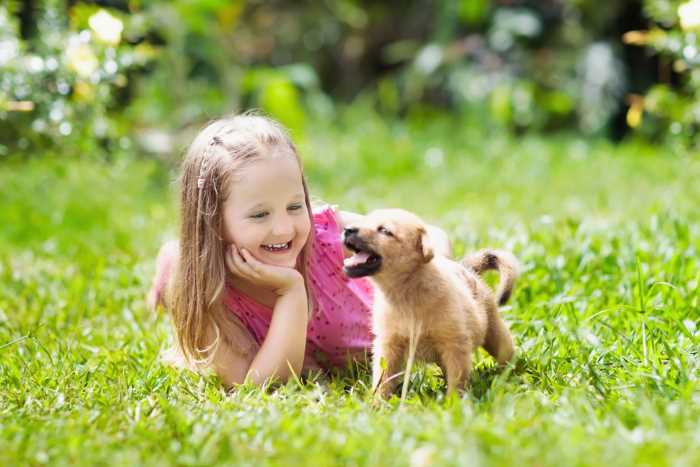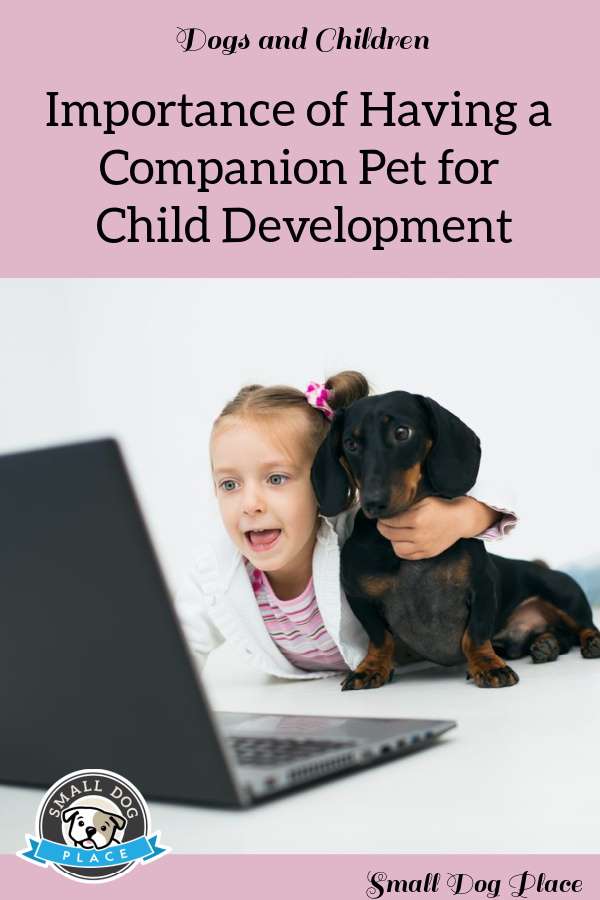Dogs and Children by Sara Anderson |Updated 07-06-2022
Most children are fascinated by pets, and there is a good reason for that. These animals teach and provide a special companionship to the young ones. Adding a feathered friend or a fury in your home will definitely be beneficial to your kids. They can lower stress and boost self-esteem not only for the children but also for adults too.
 Dogs and Children
Dogs and ChildrenElizabeth Anderson, a psychologist and the author of The Powerful Bond Between People and Pets, stated that when children and animals interact, it results in magic with healing properties.
So, if you have been thinking of adding a pet to your family or still unsure if there is a need to add one, here are a few reasons why having a companion animal is a smart idea.
Dogs and Children: How Pets Improve Child Development Outcomes
Pets Teach Kids Good Values
Besides parents and caregivers, kids can learn a few things about responsibility from their dogs and cats – for instance, the importance of being gentle and kind. Of course, you will have to take care of most of the things in the house, but your children can handle small things such as putting food in your pet’s dish.
From your examples, he or she will realize that just like humans, pets need shelter, food, and love. They also require exercise, bathroom time, and grooming. This will, in turn, teach your child about compassion and empathy. The child will know when the pet is hungry, needs a walk, or scared of the changing weather.
Besides responsibility and compassion, children can also learn to trust more when they live with pets. You see, pets such as dogs can offer necessary support when your child is sad or upset. The good thing is that their companionship is always unconditional. So, this teaches the kid to trust his or her companion, build trust in relationships, and, more importantly, trust themselves.
In older children, a pet could be a confidant. When they are going through a rough time, they can use the dog as a listening ear. They often share something they are trying or something great.
Usually, kids above 5 years old can pick on these responsibilities regarding pets’ care. Those under 4 years old should be monitored when they are with their pets.
Pets Serve as Teacher and Genuine Lover
Unlike us, most pets are non-judgmental. They are particularly friendly to children. Some of these kids could be going through emotional distress, having sibling rivalry, or are just lonely and looking for someone to talk to. In these cases, a pet like a dog can comfort them and empathize with what the child is going through. If he can get to play with your child, they can become very good friends.
In this friendship, the pet can help your child manage his or her anger. Some kids can become bullies if they don’t learn how to channel their emotions in the right places. A dog offers a safe environment for them to share their truest emotions. This will prevent them from challenging those emotions to other kids
Pets Improve Children’s Health
Childhood is a crucial life phase that contributes significantly to the emotional well-being and health of a person. Unfortunately, child development has been largely limited to interactions with humans.
What some people may not know is that animal companionship can also contribute to these areas of child development. Thankfully, recent statistics show that at least 46% of British households and 68% of American households have a pet.
Companion animals like dogs, rodents, cats, and rabbits can promote healthy physical and emotional development. While some children are extremely allergic to animals, most of the kids who grow up with animals are unlikely to develop common allergies. This can be attributed to early exposure to some bacteria, which tend to boost their immune system.
A study published in the Time also supports the above findings. It shows that exposures to pet dander could actually aid children that are still developing their immune systems. For this reason, your children will be able to fend off regular allergens and bugs.
A recent study also found out that children living with dogs are less likely to develop eczema. What is interesting is that kids with dog allergies are four times more likely to develop eczema if they do not have dogs at home.
In fact, some studies have found that people who have pets are less likely to be sick.
Another study done in 2012 found out that kids living with canines are healthier in their initial years, with fewer ear infections and respiratory issues than children who lived without dogs.
Children with active pets in their homes also tend to be fit. Physically active children will less likely be obese and will have better bone development. Additionally, they will have improved mental health, which can help them improve their academic performance.
When Dogs and Children Interact, Children Gain Self Esteem and Improved Emotional Intelligence
Besides gaining valuable skills and improving physical health, children with pets can develop better self-esteem. When these kids achieve small tasks like waking their pets, filling the water dishes, or even bathing their dogs will help them feel they are competent. In other words, it gives them a sense of accomplishment.
The Center for Disease Control and Prevention (CDC) pointed out that kids living with dogs in their homes tend to have reduced anxiety levels. It also minimizes the amount of perceived stress. The reason behind improved mental stability is that interaction with dogs can help stimulate oxytocin into the brain.
When you involve your kids in pet care, they will learn at an early stage about life and death cycles.
Pets Help Kids Socialize
A pet can help children improve their social and verbal skills. Most kids spend their earlier years learning to speak. They can accelerate the learning by attempting to chatter away to a listening pet.
So, these creatures are not only offering social support, but they are also aiding the child to develop cognitive language skills. A dog’s presence is enough to stimulate the child to start talking.
Pets Promote Play and Provide Entertainment
Having an animal who is utterly devoted is highly desirable. But have you considered them to be your entertainers? While you shouldn’t welcome pets into your home as entertainers, you can get the entertainment as a natural by-product.
Some adults tend to play with their animal companion and find joy in it. But children will be even more entertained when they have a playful animal besides them. Whether it is letting your hamster run loose in its ball or teasing your canine to chase a laser pointer, children will always find great enjoyment from these pets.
To encourage your children to play more, try putting them off the couch and away from the TV. Let them run loose with a dog, even if it’s just for 15 minutes. After all, children who engage in home exercise with a dog for 11 minutes are not only happy, but they are also less obese.
Dogs and Children and the Role of Therapy Dogs
As you may already know, 1 in every 45 children in America is struggling with autism spectrum disorder (ASD). If we put things into perspective, this figure represents about 2% of the children in the age group of 2 – 17 years.
And this introduces us to the idea of using therapy dogs. These dogs have a great impact on improving the life of a child with ASD. Without going into the details, an autistic child will benefit from therapy dogs in the following ways:
- Decrease meltdowns
- Therapy dogs offer a sense of security
- The dog increases his or her ability to face fearful situations
- Dogs help minimize anxiety and acts of aggression
- Improve social interaction as the dog can act as an icebreaker. In the process, the canine takes the focus off the kid’s disability
- Help the child try new things
- Enhances verbal communication while also helping the child increase his/her vocabulary
Besides ASD, dogs can also help children diagnosed with ADHD. With cases of ADHD increasing every year by about 2%, dogs can offer valuable support. Here are just a few of the ways a dog can help children with ADHD:
- Therapy dogs help children cope with depression and isolation
- Dogs help create a routine and consistency
- Dogs take the stress generated by a new social situation
- Provide ways of channeling excess energy, thus helping in controlling hyperactivity
Pets Helps Meet Human Needs
The biophilia hypothesis states that humans come into this world with an innate need to be in contact with nature. That is why sometimes adults prefer going to parks or walking by the beaches. It is their opportunity to relax and enjoy life.
So, when you have a family pet in your home, children will always have that contact with nature.
Dogs and Children Wrap Up
Hopefully, we have convinced you of the importance of having a companion animal in your family. Actually, there is a whole lot of value in having a dog in your home, especially if you have children. Some of these benefits relate to learning experiences, emotional and social development, and physical health development.
With that said, don’t leave your kids unsupervised. Kids less than five years may not be ready for responsibility regarding taking care of the pet.
Some of the accidents between children and pets happen around known animals. Most of the children in this age group are still learning many things. So, you should teach them to be gentle with pets.
When you are exploring different animals to add to your home, make sure to choose the one that can adapt to your lifestyle. Dogs and cats require more playtime than other pets like hamsters or turtles.
So, if your kids love to play in the yard, then a dog may be an ideal animal for them. If you are always on the move, then you might prefer a pet that can survive at home with minimal care. The good is that you could actually travel with some of them.
Dogs and Children: Pin for Future Reference

Author Bio
Sara Anderson is the head of content for the EsaCare, a medical clinic that provides world-class health care services. She has been associated with the health care industry for 10+ years and specializes in health care and medical content.
Did you find this article about Dogs and Children helpful?
Does This Article Deserve Your Thumbs Up?
We always appreciate your support and encouragement. Your thumbs up means so much to us. Please like this article.
If you find this page or any page on Small Dog Place Helpful, or Useful in anyway, I’d love it if you would click the small heart found on the bottom right of each page.
You can also share or bookmark this page — just click on the:

Free Monthly Newsletter
Sign Up for Our Free Newsletter and get our Free Gift to You.
my E-book, The Top 10 Mistakes People Make When Choosing a Dog (and how to avoid them)


